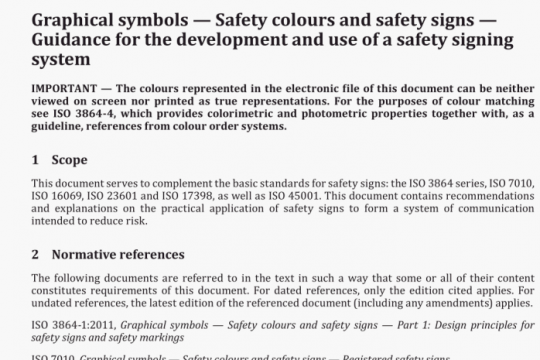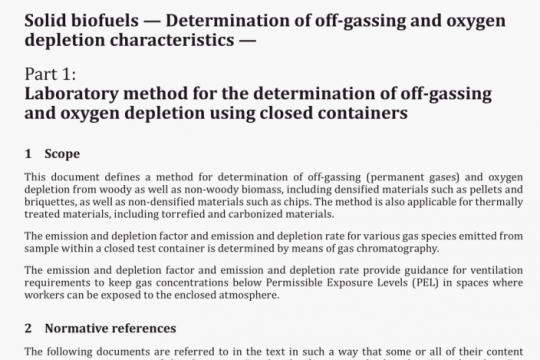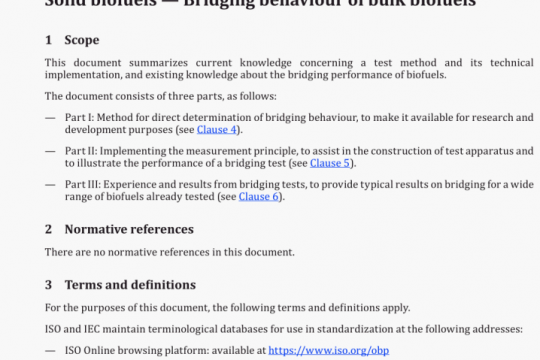ISO 8080 pdf free download
ISO 8080-2021 pdf free download.Aerospace – Anodic treatment of titanium and titanium alloys一 Sulfuric acid process.
4 Technical requirements
4.1 Process details
4.1.1 The anodizing solution shall consist of technical grade sulfuric acid in water with a nominal composition in the range from 200 g/l to 400 g/l of H2S04. The solution shall be maintained at a composition within ±10% of the nominal composition chosen. The chloride content, measured as NaCI, shall not exceed 0,2 g/l. Provided agreement is obtained from the purchaser, the chemical composition of the solution may be changed if the coating obtained meets all other requirements of this document.
4.1.2 The dissolved metal content of the solution, calculated as titanium, shall not exceed 20 g/l.
4.1.3 The solution shall be used at a temperature of (20 ± 5) °C. The temperature control equipment shall be capable of maintaining the solution temperature within ±5 °C of the control set point.
4.1.4 The solution shall be contained either in a corrosion resistant steel tank or a steel tank lined with a suitable acid resistant material. Except in cases where tanks are lead-lined, lined tanks require auxiliary cathode plates made from a material which will not contaminate the solution.
4.1.5 A variable direct current (v.d.c.) power source and associated controls and instrumentation for reading applied voltage and current are required.
4.1.6 All fixtures, such as wire, hooks, clamps and racks used to suspend the parts, shall be made from titanium or titanium alloy.
4.1.7 The following pickling solution containing a mixture of nitric and hydrofluoric acids at the
following concentrations can be used as a reference:
— 280 g/l to 560 g/l of HNO3 (690 g/kg);
— 15 g/l to 25 g/l of HF (700 g/kg).
Nitric and hydrofluoric acids concentrations can be changed, or alternative chemical products can be used, when agreed between the OEM and the processor, provided that anodic layer meets all requirements of this document.
4.2 Preparation for anodizing
4.2.1 Parts shall be thoroughly alkaline cleaned to ensure that all surfaces are free from contaminants such as grease, oil and mill markings.
4.2.2 Chlorinated solvents and methyl alcohol shall not be used for degreasing.
4.2.3 Parts shall be firmly attached to the racking device. Contact areas shall be kept as small as possible and, when practicable, shall be on a surface not required to be coated. When parts are to be coated on all surfaces, contacts shall be located on areas indicated on the drawing.
4.2.4 Parts shall be oriented so as to minimize gas entrapment during processing.
4.2.5 After cleaning, parts shall be etched for a minimum duration to guarantee surface activation in an acid pickling solution (see 4.11) and then rinsed thoroughly in cold running water. Heavily scaled parts which do not provide a clean, bright surface after the treatment outlined above may require fine alumina gritblasting or pretreatment in an oxidizing alkaline solution prior to etching.
NOTE Surface activation is correct when the surface is visually clean and bright.
4.2.6 As an alternative, a mechanical activation can be used for surface preparation if agreed between the original equipment manufacturer (OEM) and the processor.
4.3 Anodizing procedure
4.3.1 The parts shall then be immersed in the anodizing solution. The parts shall be made the anode and the tank, or auxiliary plates, the cathode. Current shall be applied to reach the desired coloration. Recommended voltage cycle: from 15 V to 20 V for a period of 15 mm or until the desired coloration has been achieved. The recommended initial current density should be approximately 0,2 A/dm2, with a reduction to an approximate value of 0,05 A/dm2 over the greater part of the anodizing cycle.
4.3.2 During processing of intricate parts, the solution should be agitated in order to minimize entrapment of gas in pockets and blind holes. If necessary parts should be repositioned periodically to bring the electrolyte into contact with uncoated areas and to prevent attack at the liquid/gas interface in pockets and blind holes.
4.3.3 After completion of the anodizing cycle, parts shall be rinsed thoroughly in cold, running water, then rinsed in clean, hot water and dried.
4.3.4 If subsequent surface treatments are to be applied, parts should be handled and stored in such a manner as to avoid them being contaminated.ISO 8080 pdf download.




